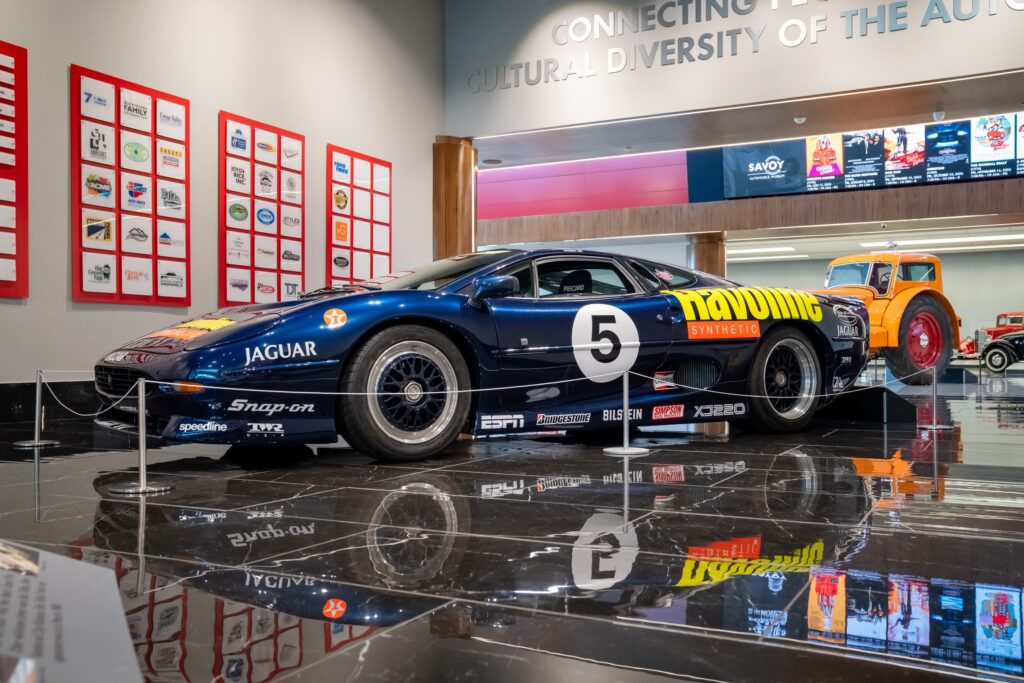Savoy Automobile Museum, Cartersville (Georgia), USA
until January 11, 2026
The exhibition “Roar of the Jaguar” at the Savoy Automobile Museum (Georgia, USA) traces the brand’s sporting history through eight iconic models, from the 1930s to the early 2000s. Although its future appears somewhat uncertain today, Jaguar remains one of the most prestigious British brands, and its glorious sporting past has earned it the admiration of many enthusiasts around the world. It is precisely this sporting past that the Savoy Automobile Museum explores in this exhibition.
Many people are unaware that Jaguar was not always called Jaguar. The brand was founded by William Lyons in 1922 under the name “Swallow Sidecar Company.” As it moved upmarket, the company changed its name in 1934 to S. S. Cars Limited, and the models were called SS. After World War II, the company resumed production of cars and changed its name for obvious reasons, taking the name Jaguar. This early period is illustrated by a splendid 1934 SS1 “Sports Tourer.”



1934 Jaguar SS1 Open Sports Tourer, On loan from Natalie & Scott Bluestein
In 1948, Jaguar introduced the XK120, one of the most desirable sports cars of the 1940s and 1950s. Its name refers to its top speed of 120 mph, or nearly 200 km/h. It was available as a coupe and roadster, and was also produced in a racing version, competing in major sporting events such as the 24 Hours of Le Mans, before giving rise to the XK140 and XK150. Two XK120 roadsters are on display, a 1954 “touring” version and a 1950 “racing” version.






1950 Jaguar XK120 Roadster (Private Collection) and 1954 Jaguar XK120 Open Two-Seater, On loan from Kim McCullough
The C-Type reused many elements from the XK120, but this time it was a true racing car and became one of the benchmarks in motor racing during the early 1950s (notably with two victories at the 24 Hours of Le Mans), before giving way to the D-Type, which continued Jaguar’s string of successes. With a monocoque structure, sophisticated aerodynamics, and four-wheel disc brakes, Jaguar continued to innovate with the D-Type, a 1955 model of which is on display.



1955 Jaguar D-Type Open Racer, On loan from Jim Taylor of Gloversville, NY
The most famous Jaguar E-Type was introduced in 1961 (known as the XK-E in the United States) and enjoyed a long life until 1975, with 6- or 12-cylinder engines, in coupe or convertible versions, and was also available in a racing version, such as this 1963 XK-E on display in the exhibition.




1963 Jaguar XKE E-Type #46 Race Car Coupe, On loan from Johan Woerheide of Atlanta, GA
We then jump forward 24 years to 1987 with the XJR-7, a sports prototype designed to compete in IMSA races in North America. A few years later, the XJR-7 evolved into the XJR-9, which raced in IMSA but also in international endurance races, notably winning the 1988 24 Hours of Le Mans.


1987 Jaguar XJR-7 IMSA – #44 GTP Race Car, On loan from the Tullius Family
In the 1980s, sports car manufacturers such as Ferrari and Porsche successfully launched their supercars, which gave Jaguar some ideas, and in turn presented its XJ220 supercar in 1988. The XJ220 was ambitious, with the 220 representing (as with the XK120 in its day) its top speed of 220 mph, or over 350 km/h. In addition to these advertised performance figures, the features of the presentation model—a V12 engine, all-wheel drive, dreamy bodywork with gullwing doors, and ground-effect aerodynamics—aroused the enthusiasm of amateurs.
Without going into its full and somewhat chaotic history (widely documented on the internet), the development process was complex: the V12 was replaced by a turbocharged V6, the transmission was no longer all-wheel drive, several comfort features were removed, and the doors reverted to a conventional opening.
In 1992, when production began, the global economic situation had deteriorated and there were fewer buyers. Production ceased in 1994 with les than 300 units produced. Nevertheless, the XJ220 remains the fastest Jaguar road car and a very beautiful car. Some models were developed for racing, such as the XJ220 on display at the Savoy Motor Museum.

1992 Jaguar XJ220 Coupe Race Car, On loan from Mike & Beth Grosso
The latest model in this exhibition is a 2009 XKR GT2, developed to compete in ALMS GT2 (the Grand Touring category of the American Le Mans Series endurance races). The car raced in 2009, 2010, and 2011, but faced with stiff competition (BMW, Corvette, Ferrari, Ford, Porsche, and Viper), the Jaguar XKR GT2 had its work cut out for it, and Jaguar withdrew from the race before it could get the most out of its car.



2009 Jaguar XKR RSR GT2 Race Car, On loan from George Keller of Columbus, OH
From 1934 to 2009, visitors to the Savoy Automobile Museum can enjoy 75 years of roaring motorsport passion.
The photos on this page belong to the Savoy Automobile Museum, no right of reproduction without the express permission of the museum.
